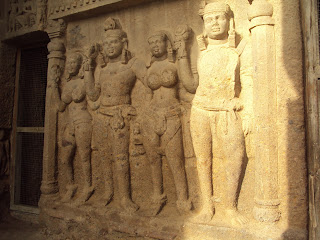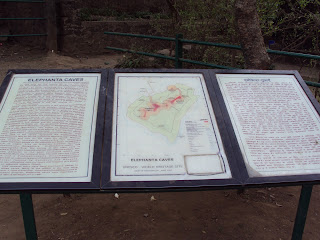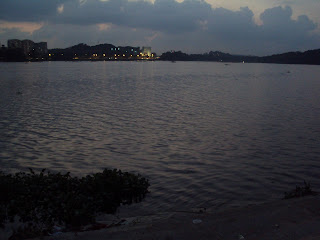This is about Mumbai and it's colors in various shades. Welcome to a wonderful journey through the city n more...
Showing posts with label Photography. Show all posts
Showing posts with label Photography. Show all posts
Sunday, 20 February 2011
Sunday, 30 January 2011
Tuesday, 11 January 2011
The Elephanta Caves
It’s a Saturday and we decided to visit The Elephanta Caves. Also it was a decision to take a local train ride this time to enjoy the Mumbai crowd. From CST a 5 minutes drive in taxi and then an hour long ferry ride through the sea to reach this beautiful spot was quite an experience.
 |
| The Island |
The Train
Info
Elephanta Caves are located on Elephanta Island in Mumbai harbor about 10kms from Mumbai city. The island got its name from huge rock elephant discovered by the Portuguese in 18th Century AD, which is now placed at Jijamata Udyaan. The solid basalt rock cut architecture in the caves has been dated between 5th to 8th century. There are seven caves in total out of which the cave number 1 contains sculptures of Lord Shiva and the famous Maheshmurti idol which earned international acclaim for the caves.
 | ||
Cave-1
|
Tuesday, 26 October 2010
Friday, 22 October 2010
A Beautiful Garden
It was a hot afternoon and we were in Sion. And soon we landed at this beautiful garden called Jawaharlal Nehru Udyan, a few meters from Sion railway station.
I loved the entire Garden. It was cool and there were so many colorful butterflies(this was my first time to see butterflies in Mumbai).
Inside this Garden is a Fort built by the Britishers in 16th Century which was majorly used as a watch tower. It is now taken care by Archeological Survey of India, whose office you can see at the base of the garden.
Now this garden is used as a place of relaxation,jogging, exercise and we saw many students studying in the peaceful environment of garden and corners of fort.
It is surely an amazing and calm place amidst the noise and crowd of Mumbai.
http://wikimapia.org/#lat=19.0461205&lon=72.8675509&z=16&l=0&m=b
I loved the entire Garden. It was cool and there were so many colorful butterflies(this was my first time to see butterflies in Mumbai).
Inside this Garden is a Fort built by the Britishers in 16th Century which was majorly used as a watch tower. It is now taken care by Archeological Survey of India, whose office you can see at the base of the garden.
 |
| Fort |
It is surely an amazing and calm place amidst the noise and crowd of Mumbai.
http://wikimapia.org/#lat=19.0461205&lon=72.8675509&z=16&l=0&m=b
Thursday, 21 October 2010
Kanheri Caves
Inside the greenary of Sanjay Gandhi National Park, Borivali exists a fabulous 2000 year old Buddhist Monarchy; Kanheri Buddhist Caves.
 |
| Beauty of Park |
 |
| Inside SGN Park towards Kanheri Caves |
This 2000 years old caves represent the monastic life in ancient India. Kanheri saw continuous occupation from the 1st century BC, until the decline of Buddhism in India in the 9th century AD.
 |
| Caves from down the road |
The carvings and architecture of Kanheri reflect both the Hinayana as well as Mahayana Buddhism.
It was a large settlement of monks, who devised ingenuous ways of sourcing and harnessing rainwater, to provide for their daily life of study and prayer.
 |
| Carved Walls |
Water cisterns, stairways chiselled into the hill, prayer halls, dormitories, and the “superior” living quarters of senior monks make Kanheri a fascinating place to visit.
The caves, taken care by the Tourism department of India lies undisturbed, in the green environment of the Sanjay Gandhi National Park. The park is spread over 9000 hectares, and is home to several species of bird and animal life, including deer, four horned antelope, leopards, macacques, civets, mongoose and langoors.
Monsoon is the best time to visit the place to enjoy the greenary and water cisterns.
Thursday, 7 October 2010
Thursday, 16 September 2010
Festival is still on...
We went to Powai lake last evening where Lord Ganesha was given a send-off on the fifth day. On the way we saw a lot of people caarrying their Ganapati and dancing. The place was heavily crowded. On reaching the spot they performed the aarti and finally handed over the idol to the trained people there for immersion.
Individuals could not perform immersion as there were specially appointed help guards wearing Yellow t-shirts helping people in the process. They were carrying the idols on two specially buit boats into the deeper side of the lake and did the immersion while carrying the smaller idols in their hands swimming into the water.
It was a nice watchable sight for me as i never saw this before. Every one one was so delighted and it was so sweet of them to allow me the chance of taking few pictures of the lord during Aarti. I would love to go for the final day immersion to see much fun and fair.

Street vendors were selling some toys and decorative items there and ofcourse i also checked in few items.
 |
| immersion spot |
Individuals could not perform immersion as there were specially appointed help guards wearing Yellow t-shirts helping people in the process. They were carrying the idols on two specially buit boats into the deeper side of the lake and did the immersion while carrying the smaller idols in their hands swimming into the water.
It was a nice watchable sight for me as i never saw this before. Every one one was so delighted and it was so sweet of them to allow me the chance of taking few pictures of the lord during Aarti. I would love to go for the final day immersion to see much fun and fair.

 |
| Children with their Ganapati |
Street vendors were selling some toys and decorative items there and ofcourse i also checked in few items.
Subscribe to:
Posts (Atom)











































